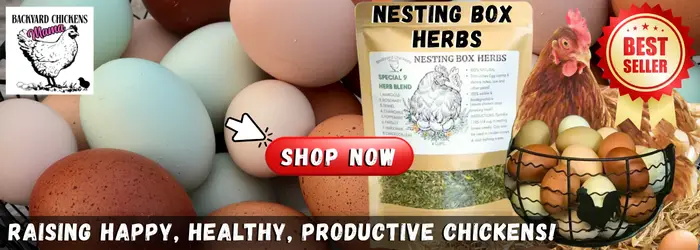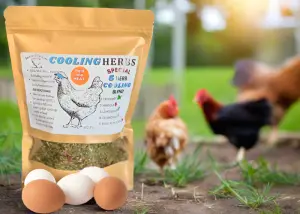
“What is chicken pasty butt?” Chicken pasty butt is what occurs when wet feces from a chickens vent, usually diarrhea, cake up and stick to the surrounding down feathers, blocking the vent. When the vent becomes blocked, feces can’t be eliminated. This needs to be attended to immediately, especially in baby chicks, or death can occur.

Nesting Box Herbs
- Increases egg laying naturally.
- Improves chicken health.
- Deters parasites: mites, lice, fleas & flies as well as mice, rats, raccoons, coyotes, opossums and more!
- On SALE!
- SHOP Nesting Box Herbs
#1 Chicken Pasty Butt Can Kill a Chick in 24 Hours

If pasty butt is not treated within the first day, it can kill a baby chick within 24 hours.
When the vent is clogged with feces, the chicks intestines become “backed up” with feces. If it backs up long enough, it becomes poisonous to a chicks whole body, causing it to die.
This is why it is important to do daily routine checks of your baby chicks butts. They should always be clean and fluffy!
Pasty Butt in Chickens
Chickens poop an average of about 14 times a day. This isn’t a problem, unless the feces are runny and become stuck to its vent. This is what you call “pasty butt in chickens.” It can happen to chickens of all ages.
- Different illnesses and diseases can cause a chicken to develop diarrhea.
- Stress is another trigger for diarrhea in chickens.
Baby chicks are especially prone to developing pasty butt during the first few weeks of life due to being exposed to many stressful events:
Stressful Events Causing Chicken Pasty Butt in Chicks
- Hatching out of the shell in itself is a stressful event.
- new environment
- fluctuating temperatures
- new foods
- lack of food or water
- being held too much
- lack of space
- predators or family pets
- illnesses or disease
If a chick gets pasty butt, you will need to bathe its backend right away in order to remove the feces. They are not able to remove this on their own. Sometimes, but not always, you will need to do this with adult chickens as well.
See #5 below for step by step instructions for how to bathe a chick or chicken with pasty butt.
- Dried poop stuck to vent area
- Lethargy (Weak chick or chicken)
- Not eating and drinking
- Chick likely off on its own
- Eyes closed
A chick or chicken with pasty butt will have a clump of brown, dried feces on its backend, blocking the vent area.
In a baby chick, you can check for this by picking them up and looking right under its tail. Adult chickens, it is quite evident and you will not need to flip them over to see a matte of feces stuck to their bum.
If a chicken is not able to pass feces, it will begin to back up into the intestines. Little chicks will begin to show symptoms quicker than an adult chicken.
If pasty butt isn’t treated right away, it can lead a chick or chicken to stop eating and drinking, causing it to become weak. Many times a chick suffering from this may be off in a corner with its eyes closed.
- Feed Dried Oats! Blend up some plain, dried oats in a blender and serve it to them on the side. This will firm up their poop. Ever since I have started my baby chicks on dried oats as a supplement to their regular chick starter feed, I have never had a chick with pasty butt.
- Maintain Proper Brooder Temperature: Chicks that are either too hot or too cold are most likely to develop pasty butt. Baby chicks need to be provided with the proper temperature for the first 6 weeks of their life. This is when they are working on growing in their first set of feathers.
- Eliminate any Stressors: This includes moving them to a different location, holding them too much, family cat or dog pestering them, lack of fresh food and water, etc.
- Provide Grit. If you feed your chicks anything other than the commercial chick starter, they need to be provided with grit. Grit are fine stones or rock fragments that help aid in the digestion of food.
- Do daily visual vent checks, especially if your chicken is ill and clean the vent area as needed.
#4 Most Adult Chickens will Dust Bathe to Remove a Pasty Butt

- Adult chickens will naturally dust bathe to remove pasty butt. If they are unable to do this on their own, you may need to intervene.
- Dust bathing helps to remove excess oils from the feathers
- Taking a dust bath helps to deter mites lice, fleas and other parasites
Dust bathing is a chickens natural way of cleaning itself. Just as we take a shower, a chicken will take a dust bath.
It can be quite alarming the first time your see a chick take a dust bath. Chicks in their first week of life will even do it!
Chickens like to dig a little hole in the dirt or bedding and then will lie down on their side. Once on their side, they will proceed to fling up the dirt on top of themselves.
Make sure to stand back if you see a chicken doing this, otherwise you may find yourself getting a little dust bath yourself!
Dirt will also remove any excess oils in their feathers, leaving them cleaner and fluffier after they shake off.
It also helps to deter any mites, lice, fleas and other parasites from hitch hiking on them.

#5 How to Properly Bathe a Chick with Pasty Butt (this works for adult chickens too!)
You only need to clean a chicks backend if they develop pasty butt. You do not need to bathe the whole body. Chicks get chilled quite quickly, so the less wet they become, the better.
Step by Step Instructions – How to Properly Bathe a Chick with Pasty Butt
Step 1: How to Bathe a Chick with Pasty Butt
Put on a pair of latex gloves. Chicken poop can contain many different diseases that can be passed on to humans. Don’t skip this step because you will need to use your hands to help loosen the poop from a chicks bottom.
According to the CDC, humans CAN contract salmonella and other diseases from coming into contact with infected chicken poop.
For dried or hardened chicken poop blocking the vent, go to step 2. For softer chicken poop building up by the vent you can use a wet, warmed towel to gently brush the poop away from the vent and move to Step 6.
Fill a pan with lukewarm water. For baby chicks, you will only need it to be about 1″ deep. For adult chickens, you can fill a dish pan about 1/2 way full.
Step 3: How to Bathe a Chick with Pasty Butt
Let your chick or chicken set in this warm water for 1 minute. You will need to gently hold your baby chick or chicken in place during this step. This will help to loosen the dried out poop, making it easier to remove.
Step 4: How to Bathe a Chick with Pasty Butt
After 1 minute has passed, gently rub your gloved hand over the poop. Most of it should come loose. If it doesn’t, let your chick sit a little longer in warm water.
CAUTION: DO NOT PULL THE POOP OFF. Pulling poop off can pull the hair and some of the surrounding skin off, causing the chick to bleed. Due to its small size, young chicks do not tolerate blood loss well.
Step 5: How to Bathe a Chick with Pasty Butt
Remove chick or chicken from the shallow pan of water and rinse its backend under gently running warm water. This will remove any additional soft poop from the fluff or feathers.
CAUTION: Make sure the water is warmed before placing your chicks bottom under the water. Test with your hand first.
Step 6: How to Bathe a Chick with Pasty Butt
Take a dry, warm towel to soak up as much of the water as possible from your chick or chicken.
Step 7: How to Bathe a Chick with Pasty Butt
Use a hair blower on low heat setting, NOT HOT, and gently dry your chick until its backend is all fluffed up again. Take special care to keep the hair blower moving and not hold it one position.
Chickens are attracted to bright red colors and if they see any blood or redness on a chick or chickens backend, they will peck at it!
Conclusion: What is Chicken Pasty Butt? 5 Important Facts You Need to Know
- Chicks can die within 24 hours of having pasty butt.
- Know the signs of pasty butt.
- dried, brown feces caked on vent area
- not eating and drinking well
- chicks/chickens look weak
- chicks/chickens off on their own
- eyes closed
- Prevention is Key
- eliminate stressors
- maintain proper temperature
- clean water and proper diet
- feed dried oats
- Dust Bathing in Chickens
- If adult chickens cannot clean themselves by dust bathing, you may have to intervene.
- Know the proper way to bathe a chick or chicken if you have to intervene.
- Never pull off dried feces, this can also pull the chickens downy feathers out with it, causing it to bleed.
- Soften the feces with either a wet, warmed cloth or soaking the chicks backend in a shallow pan of warmed water to soften it.
- Take care not to chill the chick or chicken and dry them off completely before placing them back in with the rest of the flock.
What is Chicken Pasty Butt? 5 Important Things You Need to Know– https://www.backyardchickensmama.com/what-is-chicken-pasty-butt-important-facts/








